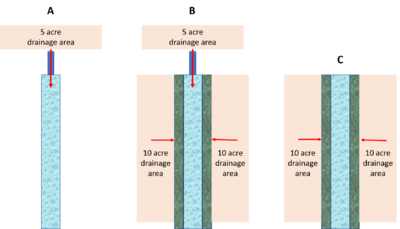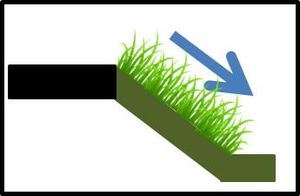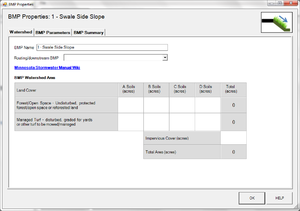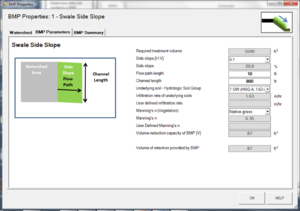
Difference between revisions of "Requirements, recommendations and information for using swale side slope as a BMP in the MIDS calculator"
m |
|||
| Line 21: | Line 21: | ||
**'''Manning’s n (Vegetation):''' The user selects a type of vegetation cover on the swale side slope, which populates a corresponding Manning’s n. The vegetation types are mowed turf or native grasses. Mowed turf would be selected if the side slope is mowed on a consistent basis. Native grasses would be selected if the side slope is left to grow or is mowed infrequently. Once a vegetation cover is selected, the corresponding Manning’s n will populate in the ''Manning’s n'' field. The user may also select ''User Defined''. This selection will activate the ''User Defined Manning’s n'' cell allowing the user to enter a value different from the values in the predefined selection list. | **'''Manning’s n (Vegetation):''' The user selects a type of vegetation cover on the swale side slope, which populates a corresponding Manning’s n. The vegetation types are mowed turf or native grasses. Mowed turf would be selected if the side slope is mowed on a consistent basis. Native grasses would be selected if the side slope is left to grow or is mowed infrequently. Once a vegetation cover is selected, the corresponding Manning’s n will populate in the ''Manning’s n'' field. The user may also select ''User Defined''. This selection will activate the ''User Defined Manning’s n'' cell allowing the user to enter a value different from the values in the predefined selection list. | ||
*'''BMP Summary Tab:''' The BMP Summary tab summarizes the volume and pollutant reductions provided by the specific BMP. It details the performance goal volume reductions and annual average volume, dissolved P, particulate P, and TSS load reductions. Included in the summary are the total volume and pollutant loads received by the BMP from its direct watershed, from upstream BMPs and a combined value of the two. Also included in the summary are the volume and pollutant load reductions provided by the BMP, along with the volume and pollutant loads that exit the BMP through the outflow. This outflow load and volume is what is routed to the downstream BMP, if one is defined in the Watershed tab. Finally, percent reductions are provided for the percent of the performance goal achieved, percent annual runoff volume retained, total percent annual particulate phosphorus reduction, total percent annual dissolved phosphorus reduction, total percent annual TP reduction, and total percent annual TSS reduction. | *'''BMP Summary Tab:''' The BMP Summary tab summarizes the volume and pollutant reductions provided by the specific BMP. It details the performance goal volume reductions and annual average volume, dissolved P, particulate P, and TSS load reductions. Included in the summary are the total volume and pollutant loads received by the BMP from its direct watershed, from upstream BMPs and a combined value of the two. Also included in the summary are the volume and pollutant load reductions provided by the BMP, along with the volume and pollutant loads that exit the BMP through the outflow. This outflow load and volume is what is routed to the downstream BMP, if one is defined in the Watershed tab. Finally, percent reductions are provided for the percent of the performance goal achieved, percent annual runoff volume retained, total percent annual particulate phosphorus reduction, total percent annual dissolved phosphorus reduction, total percent annual TP reduction, and total percent annual TSS reduction. | ||
| + | |||
| + | ==Routing stormwater runoff to swales and swale side slopes in the MIDS Calculator== | ||
| + | {{:Routing stormwater runoff to swales and swale side slopes in the MIDS Calculator}} | ||
==Model input requirements and recommendations== | ==Model input requirements and recommendations== | ||
Revision as of 21:53, 7 June 2021
The swale side slope BMP is used in combination with one of the three main channel BMPs (Swale Main Channel, Swale Main Channel with an underdrain, or Wet Swale). This BMP should not be used as a standalone BMP as the credits were determined as part of a swale system. The swale side slope must receive stormwater runoff from the direct watershed through sheet flow over the entire channel length. If the stormwater flow is channelized when it reaches the swale side slope, the swale main channel component should be used without the swale side slope component. The swale side slope BMP represents one side slope of a swale system. If a swale contains two side slopes that each receive runoff through sheet flow from impervious surfaces, then two swale side slopes should be used in the calculator and each routed to the corresponding swale main channel BMP. Credit toward the volume performance goal for a swale side slope is based on annual infiltration into the soils. Due to the fact that the performance goal is an instantaneous credit, a relationship between an annual volume reduction and the instantaneous credit was created. All pollutants in the infiltrated water are credited as being reduced.
Contents
- 1 MIDS calculator user inputs for swale side slope
- 2 Routing stormwater runoff to swales and swale side slopes in the MIDS Calculator
- 3 Model input requirements and recommendations
- 4 Methodology
- 5 Routing
- 6 Assumptions for swale side slope
- 7 Swale side slope and Main channel example (Version 2)
- 8 Requirements
- 9 Recommendations
- 10 Information
- 11 Links to MIDS pages
MIDS calculator user inputs for swale side slope
For swale side slope BMPs, the user must input the following parameters to calculate the stormwater volume and pollutant load reductions.
- Watershed tab
- BMP Name: this cell is auto-filled but can be changed by the user.
- Routing/downstream BMP: if this BMP is part of a swale system and water is being routed from this BMP to a main channel swale, the user selects the name of the BMP to which water is being routed from the dropdown box. All water must be routed to a single BMP. Note that the user must include the BMP receiving the routed water in the Schematic or the BMP will not appear in the dropdown box. This BMP can only be routed to a Swale main channel, Swale main channel (with underdrain), or a Wet swale BMP.
- BMP Watershed Area: BMP watershed areas are the areas draining directly to the BMP. Values can be added for four soil types (Hydrologic Soil Groups (HSG) A, B, C, D) and for three Land Cover types (Forest/Open Space, Managed Turf, and Impervious Cover). The surface area of the BMP should be included as a managed turf land cover under the hydrologic soils group of the native soils located under the BMP. Units are in acres.
- BMP Parameters tab
- Side slope [H:V]: The user selects the ratio between the horizontal (H) and vertical (V) components of the side slope (H:V) from a drop down menu . The values available for selection are 3:1, 4:1, 5:1, 6:1, and 7:1. By selecting a horizontal to vertical side slope ratio, the corresponding Side slope (%) will populate automatically. This value should be an average for the length of the swale.
- Flow path length: This is the average diagonal distance between the highest elevation point and lowest elevation point of the side slope taken perpendicular to the main channel throughout the length of the swale. This could also be described as the width of the side slope. Units are in feet.
- Channel length: This is the length of the side slope from the farthest point upstream to the farthest point downstream of the main channel. Flow must occur as sheet flow over the entire channel length (if not, the channel length should be adjusted to only cover areas where sheet flow occurs). Units are in feet.
- Underlying soil - Hydrologic Soil Group: The user selects the most restrictive soil (lowest hydraulic conductivity) within 5 feet of the soil surface of the swale side slope. There are 14 soil options that fall into 4 different Hydrologic Soil Groups (Hydrologic Soil Group (HSG) A, B, C, or D) for the user. Once a soil type is selected, the corresponding infiltration rate will populate in the Infiltration rate of underlying soils field. The user may also select User Defined. This selection will activate the User defined infiltration rate cell allowing the user to enter a different value from those in the predefined selection list. The maximum allowable infiltration rate is 1.63 inches per hour.
- Manning’s n (Vegetation): The user selects a type of vegetation cover on the swale side slope, which populates a corresponding Manning’s n. The vegetation types are mowed turf or native grasses. Mowed turf would be selected if the side slope is mowed on a consistent basis. Native grasses would be selected if the side slope is left to grow or is mowed infrequently. Once a vegetation cover is selected, the corresponding Manning’s n will populate in the Manning’s n field. The user may also select User Defined. This selection will activate the User Defined Manning’s n cell allowing the user to enter a value different from the values in the predefined selection list.
- BMP Summary Tab: The BMP Summary tab summarizes the volume and pollutant reductions provided by the specific BMP. It details the performance goal volume reductions and annual average volume, dissolved P, particulate P, and TSS load reductions. Included in the summary are the total volume and pollutant loads received by the BMP from its direct watershed, from upstream BMPs and a combined value of the two. Also included in the summary are the volume and pollutant load reductions provided by the BMP, along with the volume and pollutant loads that exit the BMP through the outflow. This outflow load and volume is what is routed to the downstream BMP, if one is defined in the Watershed tab. Finally, percent reductions are provided for the percent of the performance goal achieved, percent annual runoff volume retained, total percent annual particulate phosphorus reduction, total percent annual dissolved phosphorus reduction, total percent annual TP reduction, and total percent annual TSS reduction.
Routing stormwater runoff to swales and swale side slopes in the MIDS Calculator
The Minimal Impact Design Standards (MIDS) Calculator separates side slopes and the main channel of swales into separate practices. This creates the potential for inaccurately routing water, since in reality side slopes and main channels are part of a single swale system. This page provides guidance for routing water to swales in the MIDS Calculator.
Swale configuration in the MIDS Calculator
The MIDS Calculator separates swale side slopes and swale main channels into separate best management practices. This is because infiltration and pollutant retention calculations differ for the side slope and the main channel. Descriptions of modeling assumptions and calculations are found at the following links.
The primary difference between side slopes and main channels is due to increased potential for infiltration in a main channel resulting from different configurations. Specifically, infiltration in a main channel is affected by length of the swale, presence or absence of impermeable check dams, and presence or absence of engineered media. These configurations are either not available for side slopes or have limited impact on infiltration.
Potential swale configurations

In reality, swale side slopes and main channels are part of a single swale practice. There are three possible configurations of swales. Configuring and routing water to them correctly is essential to correctly modeling swales.
- Swale main channels with direct discharge to it and no side slopes. This situation is rare, but there may be situations where water is discharged, such as from a pipe, directly into a swale and the swale has no side slopes.
- Swale main channels with direct discharge to it and one or more side slopes.
- Swale main channels with one or more side slopes and no direct discharges to the swale.
These configurations are shown in the adjacent image.
Configuring and routing water to a swale practice
- Swale main channels with direct discharge to it and no side slopes. In this situation, only the swale main channel is used in the MIDS Calculator.
- If the discharge water to the swale main channel is coming directly from another treatment practice, such as a bifiltration practice (e.g. bioretention with an underdrain), do not enter any contributing pervious or impervious acreage to the swale main channel. Make sure the upstream practice is being routed to the swale main channel.
- If the discharge water to the swale main channel is not from another treatment practice, enter the impervious and pervious acres contributing to this discharge into the Watershed tab for the swale BMP properties.
- If the discharge water to the swale main channel contains both treated and untreated water, enter only acreages contributing to the untreated discharge. Make sure the upstream BMP for the treated water is routed to the swale main channel.
- Swale main channels with direct discharge to it and one or more side slopes. For this situation, apply the above methodology to the direct discharge to the main channel. For the side slope, enter pervious and impervious acres to the Watershed tab for the swale side slope and route the side slope to the main channel. DO NOT ROUTE THESE ACREAGES TO THE MAIN CHANNEL. If there is more than one side slope, use multiple side slopes routed to the one main channel.
- Swale main channels with one or more side slopes and no direct discharges to the swale. If all the discharge to the main channel is from swale side slopes, enter pervious and impervious acres to the Watershed tab for the swale side slope and route the side slope to the main channel. DO NOT ROUTE THESE ACREAGES TO THE MAIN CHANNEL. If there is more than one side slope, use multiple side slopes routed to the one main channel.
Model input requirements and recommendations
If the following requirements for inputs into the MIDS calculator are not met, then an error message will inform the user to change the input to meet the requirement.
- Infiltration rates of the underlying soils cannot exceed 1.63 inches per hour.
- The Manning’s n value cannot be greater than 1.
Methodology
Required Treatment Volume
Required treatment volume, or the volume of stormwater runoff delivered to the BMP, equals the performance goal (1.1 inches or user-specified performance goal) times the impervious area draining to the BMP. Since no BMP can be routed to a swale side slope, no additional water can be routed to the swale side slope from an upstream BMP. Stormwater is delivered to the BMP instantaneously.
Volume Reduction
A swale side slope does not have storage capacity as do most other BMPs in the MIDS calculator. Volume reduction occurs only through infiltration as the stormwater travels over the side slope. To obtain an instantaneous Volume reduction capacity of BMP [V] for a swale side slope based on user inputs, annual volume reductions were determined and converted to a volume reduction capacity credit. The Volume of retention provided by BMP is the total instantaneous volume credit that can be claimed for that BMP, and is determined by comparing the Volume reduction capacity of BMP [V] to the Required treatment volume.
To determine the annual volume reduction credit given for a swale side slope, the P8 water quality model was used. 55 years of hourly rainfall data were modeled for swale side slopes with various configurations of side slope, flow path length, channel length, soil infiltration rate, and Manning’s n parameters. The model results provided annual average volume reduction rates. Multivariate regression was used to assess model results to determine the relationships between swale modeling parameters and annual volume reductions. The observed relationships are paired with the user-provided inputs to calculate an annual percent stormwater volume reduction for the swale side slope in the calculator.
To obtain the instantaneous Volume reduction capacity of BMP [V] side slope, the annual volume reductions are converted to an instantaneous volume reduction capacity. This is accomplished through the use of performance curves developed from a range of modeling scenarios. The performance curves use the annual volume reduction percentage, the infiltration rate of the underlying soils, the contributing watershed percent impervious area, and the size of the contributing watershed to calculate the Volume reduction capacity of BMP [V].
The MIDS calculator compares the Volume reduction capacity of BMP [V] with the Required treatment volume, and the lesser of the two values is used to populate the Volume of retention provided by BMP. This comparison between potential and actual treatment volumes ensures that the BMP does not claim more credit than is due based on the actual amount of water routed to it. The Volume of retention provided by BMP is thus the actual volume credit the BMP receives toward the instantaneous performance goal. For example, if the BMP is oversized the user will only receive volume credit for the Required treatment volume routed to the BMP.
Pollutant Reduction
Pollutant removal is accomplished through infiltration (volume reduction) in this BMP. Pollutant load reductions are thus dependent upon the volume of water retained by the BMP, and are calculated on an annual basis. The first step in calculating annual pollutant load reductions is to determine the Annual retention volume provided by BMP as discussed in the above Volume reduction section. A 100 percent pollutant removal rate is applied to this infiltrated stormwater for total suspended solids, dissolved phosphorus, and particulate phosphorus. Thus, while oversizing a BMP above the Required treatment volume will not provide additional credit towards the performance goal volume, it may provide additional annual volume and pollutant load reduction. Pollutants not removed through infiltration are routed to the downstream swale main channel.
NOTE: The user can modify event mean concentrations (EMCs) on the Site Information tab in the calculator. Default concentrations are 54.5 milligrams per liter for total suspended solids (TSS) and 0.3 milligrams per liter for total phosphorus (particulate plus dissolved). The calculator will notify the user if the default is changed. Changing the default EMC will result in changes to the total pounds of pollutant reduced.
Routing
The swale side slope BMP is designed to be part of a system with a corresponding swale main channel BMP. Therefore, a swale side slope BMP can only be routed to one of the three main channel BMPs: Swale Main Channel, Swale Main Channel (with underdrain), or Wet Swale. The swale side slope BMP should not be used as a standalone BMP. It should always be used in combination with one of the three main channel BMPs. The swale side slope BMP requires sheet flow over its surface area to receive credit. Therefore, no other BMP can be routed to the swale side slope BMP. It can only receive runoff from the direct watershed.
Assumptions for swale side slope
The following general assumptions apply in calculating the credits for a swale side slope. If these assumptions are not followed, the volume and pollutant reduction credits cannot be applied.
- The swale side slope has been properly designed, constructed, and will be properly maintained according to specifications for filtration systems.
- The swale side slope is being used in combination with one of the three swale main channel components.
Swale side slope and Main channel example (Version 2)
Swale side slope should be used in conjunction with a main channel swale. Examples are contained in the appropriate section for the main channel swales.
- Example for Swale main channel without an underdrain
- Example for Swale main channel with an underdrain
- Example for Wet swale
Requirements

- At least a 3 foot separation from the bottom of an infiltration system to the seasonal high water table
- Use the most restrictive infiltration rate within 5 feet of the bottom of the BMP
- For measured infiltration rates, apply a safety factor of 2
- Pretreatment for infiltration systems
Recommendations
- Drawdown time of 24 hours when the discharge is to trout streams
- Use of field tested infiltration rates rather than table values
Information
- Guidance on determining infiltration rates
- Information on site constraints (shallow soil, karst, etc.)
- Guidance on pretreatment
- Information on soil mixes
- Construction specifications for filtration BMPs
- Information on operation and maintenance of filtration BMPs.
Links to MIDS pages
- Overview of Minimal Impact Design Standards (MIDS)
- Performance goals for new development, re-development and linear projects
- Design Sequence Flowchart-Flexible treatment options
- Community Assistance Package
- MIDS calculator
- Performance curves for MIDS calculator
- Training and workshop materials and modules
- Technical documents


